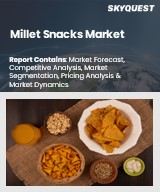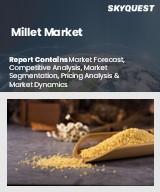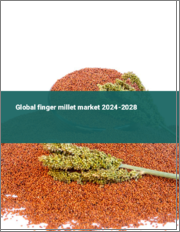
|
시장보고서
상품코드
1438178
세계의 잡곡 시장 예측(-2030년) : 제품 유형별, 유통채널별, 최종사용자별, 지역별 분석Millets Market Forecasts to 2030 - Global Analysis By Products Type (Pearl Millet, Foxtail Millet, Sorghum Millet, Finger Millet, Proso Millet, Barnyard Millet and Other Products Types), Distribution Channel, End User and By Geography |
||||||
Stratistics MRC에 따르면 세계의 잡곡 시장은 2023년에 108억 달러를 차지했고, 예측 기간 동안 CAGR 6.6%로 성장하고, 2030년에는 170억 달러에 이를 전망입니다.
잡곡은 인간의 식용으로 재배되는 씨앗이 적은 목초의 그룹을 말합니다. 영양가가 높은 곡물로 수수, 펄 밀렛, 손가락조, 조, 기장 등 다양한 유형가 있습니다. 잡곡은 다양한 환경 조건에 강한 것으로 알려져 있으며 다른 곡물에 비해 물이 필요하지 않습니다. 단백질,식이 섬유, 비타민, 미네랄 등의 영양소를 풍부하게 포함하여 세계의 식생활에서 귀중한 존재가되고 있습니다. 이 곡물은 폴리지, 빵, 시리얼, 음료 등 다양한 요리에 사용됩니다.
유엔 식량농업기관(FAO)에 따르면 세계 잡곡 생산량은 2019년 2,833만 톤으로 추정되고, 2021년에는 3,008만 톤으로 증가합니다. 인도는 세계 최대의 생산국으로, 2021년 세계 시장 점유율은 43.0%이며, 수수(jowar), 펄 밀렛(bajra), 손가락조(ragi), 기타 잡곡이 재배되고 있습니다.
글루텐 프리 제품에 대한 수요 증가
건강 지향 소비자 선호도가 증가함에 따라 글루텐 프리 제품에 대한 수요가 급증하고 있습니다. 글루텐 불내증과 라이프스타일의 선택으로 글루텐이 없는 식사를 선택하는 사람이 늘어남에 따라, 잡곡을 기반으로 한 글루텐이 없는 대체 식품 수요가 확대되고 있습니다. 천연 글루텐이없는 영양가가 높은 잡곡은 선호되는 옵션이되어 시장은 건강 지향 소비자층 증가에 대응하기 위해 제품 라인업의 확충을 촉진하고 있습니다.
가공 및 유통의 과제
잡곡의 가공과 유통은 제한된 인프라, 과거의 기술, 부적절한 저장 설비 등의 과제에 직면하고 있습니다. 표준화된 가공 방법이나 운송망이 없는 것은 효율적인 유통을 방해하고 있습니다. 수요와 시장 접근이 불안정하다는 것은 공급망을 더욱 복잡하게 만듭니다. 게다가 수요를 환기시키기 위해서는 잡곡의 영양면에서의 이점에 대한 인식을 높여야 합니다. 이러한 과제는 전체적으로 시장에서 잡곡의 입수성, 품질, 보급에 영향을 미칩니다.
건강과 영양에 대한 의식
잡곡은 그 영양가의 높이, 지속가능성, 다용도성으로부터 지지를 모으고 있습니다. 건강 지향이 높아짐에 따라 글루텐 프리로 영양가가 높고 글리세믹 지수가 낮다는 잡곡의 장점에 대한 인식도 높아지고 있습니다. 시장에서의 부활은 더 건강한 식생활로의 변화를 반영하며 균형 잡힌 식생활을 추구하는 사람들에게 다양한 옵션을 제공합니다. 이 동향은 지속 가능하고 다양한 음식 선택에 대한 관심 증가와 일치하여 잡곡 시장을 전진시킵니다.
가격변동과 경제요인
잡곡 시장의 가격 변동은 여러 경제적 요인에 영향을 받습니다. 소비자의 취향의 변화에 의한 수요의 변동, 수확에 영향을 주는 날씨 조건에 의한 공급의 제한, 생산과 유통에 영향을 주는 농업 정책 등이 이 변동의 원인이 되고 있습니다. 또한 세계 시장 역학, 무역 규제, 통화 변동도 기장 가격에 영향을 미치고 시장에 불확실성을 가져다줍니다.
COVID-19의 영향:
COVID-19의 유행은 세계의 잡곡 시장에 큰 영향을 미쳤습니다. 처음에는 공급망의 혼란이 공급 부족을 초래하여 생산과 유통에 영향을 주었습니다. 그러나 잡곡의 영양가에 대한 인식이 높아짐에 따라 수요가 급증하고 잡곡 생산자에게 비즈니스 기회가 생겨났습니다. 보다 건강하고 글루텐이없는 옵션에 대한 소비자의 관심 증가는 잡곡의 판매를 밀어 올렸습니다. 또한 기후 변화에 대응할 수 있는 탄력성이 있는 작물이 요구되는 가운데, 지속가능한 작물로서 잡곡이 주목받게 되었습니다. 당초의 과제에도 불구하고, 유행은 궁극적으로 호전의 계기가 되어 영양면에서의 이점과 적응성에 의해 잡곡 시장 전망을 높였습니다.
예측 기간 동안 펄 밀렛 부문이 최대가 될 것으로 예상
펄 밀렛 부문은 예측 기간 동안 최대가 될 전망입니다. 다양한 요리에 대한 범용성과 단백질, 식이 섬유, 미량 영양소를 풍부하게 포함하는 영양가가 그 수요를 뒷받침하고 있습니다. 어려운 기후에 적응하기 때문에 건조 조건에 직면 한 지역의 주식으로 사용됩니다. 당뇨병 관리와 소화 개선 등 건강상의 이점에 대한 인식이 높아져 건강 지향 시장에서 인기가 급상승하고 있습니다.
베이커리 부문은 예측 기간 중 가장 높은 CAGR이 예상된다.
베이커리 부문은 예측 기간 동안 가장 높은 CAGR이 예상됩니다. 전통적인 레시피에 현대적인 트위스트를 더해 갓 구운 다양한 상품으로 미각을 자극합니다. 플레이크 모양의 크로와상에서 천국과 같은 케이크까지 하나하나의 작품은 기술과 열정의 증거입니다. 황금빛으로 빛나는 따뜻한 빵의 향기가 점내를 감싸고 고객을 극상의 구운 과자에 초대합니다.
최대 점유율을 차지하는 지역
북미는 건강 지향 소비자 동향 증가로 예측 기간 동안 최대 시장 점유율을 차지할 것으로 예측됩니다. 영양가가 높고 글루텐이 없는 성질로 알려진 잡곡은 다양하고 지속 가능한 음식의 선택을 요구하는 소비자들 사이에서 지지를 모으고 있습니다. 보급에는 과제가 있는 것, 잡곡이 건강에 좋다는 인식이 높아지고, 다양한 식품에 도입되어, 건강 식품점이나 온라인 플랫폼에서의 존재감이 늘어남에 따라, 시장은 유망시되고 있습니다.
CAGR이 가장 높은 지역:
아시아태평양은 건강 의식 증가와 글루텐 프리 음식의 보급으로 예측 기간 동안 가장 높은 CAGR을 유지할 것으로 예측됩니다. 영양이 풍부하고 가뭄에 강한 작물인 잡곡은 소비자와 농가들 사이에서 인기를 얻고 있습니다. 그 장점에 대한 인식 증가와 재배를 촉진하는 정부의 대처가 함께 시장 확대에 박차를 가하고 있습니다. 다양한 잡곡 기반 제품이 합리적인 가격으로 얻을 수 있기 때문에이 지역은 잡곡 소비의 중심지가되어 지속 가능한 음식 선택을 요구하는 건강 지향 소비자를 수용합니다.
무료 맞춤형 서비스
이 보고서를 구독하는 고객은 다음 무료 맞춤설정 옵션 중 하나를 사용할 수 있습니다.
- 기업 프로파일
- 추가 시장 기업의 종합적 프로파일링(3개사까지)
- 주요 기업의 SWOT 분석(3개사까지)
- 지역 세분화
- 고객의 관심에 응한 주요국 시장 추계·예측·CAGR(주: 타당성 확인에 따름)
- 경쟁 벤치마킹
- 제품 포트폴리오, 지리적 존재, 전략적 제휴에 기반한 주요 기업 벤치마킹
목차
제1장 주요 요약
제2장 서문
- 개요
- 이해관계자
- 조사 범위
- 조사 방법
- 데이터 마이닝
- 데이터 분석
- 데이터 검증
- 조사 접근
- 조사 소스
- 1차 조사 소스
- 2차 조사 소스
- 전제조건
제3장 시장 동향 분석
- 성장 촉진요인
- 억제요인
- 기회
- 위협
- 제품분석
- 최종 사용자 분석
- 신흥 시장
- COVID-19의 영향
제4장 Porter's Five Forces 분석
- 공급기업의 협상력
- 구매자의 협상력
- 대체품의 위협
- 신규 참가업체의 위협
- 경쟁 기업간 경쟁 관계
제5장 세계의 잡곡 시장 : 제품 유형별
- 펄 밀렛
- 조
- 수수조
- 손가락조
- 기장
- 피
- 기타
제6장 세계의 잡곡 시장 : 유통 채널별
- 업계 단체
- 슈퍼마켓
- 식료품점
- 온라인 플랫폼
제7장 세계의 잡곡 시장 : 최종 사용자별
- RTE 식품
- 베이커리
- 음료
- 조식
- 사료
- 기타
제8장 세계의 잡곡시장 : 지역별
- 북미
- 미국
- 캐나다
- 멕시코
- 유럽
- 독일
- 영국
- 이탈리아
- 프랑스
- 스페인
- 기타 유럽
- 아시아태평양
- 일본
- 중국
- 인도
- 호주
- 뉴질랜드
- 한국
- 기타 아시아태평양
- 남미
- 아르헨티나
- 브라질
- 칠레
- 기타 남미
- 중동 및 아프리카
- 사우디아라비아
- 아랍에미리트(UAE)
- 카타르
- 남아프리카
- 기타 중동 및 아프리카
제9장 주요 발전
- 계약/파트너십/협업/합작투자(JV)
- 인수와 합병
- 신제품 발매
- 사업 확대
- 기타 주요 전략
제10장 기업 프로파일
- Cargill
- Archer Daniels Midland Company
- Britannia
- BrettYoung
- Kerry Group plc
- BASF SE
- Nestle SA
- Croda International Plc
- Crystal Crop Protection Pvt. Ltd.
- Bayer Crop Science AG
- Allied Seed, LLC
- Ernst Conservation Seeds
- Mayoora Foods
- Navan Foods, LLC
- Sydler India Pvt. Ltd.
- Nature's Logic.
- Sresta Natural Bioproducts Pvt. Ltd.
According to Stratistics MRC, the Global Millets Market is accounted for $10.8 billion in 2023 and is expected to reach $17.0 billion by 2030 growing at a CAGR of 6.6% during the forecast period. Millets refer to a group of small-seeded grasses that are cultivated for human consumption. They are highly nutritious grains and include various types such as sorghum, pearl millet, finger millet, foxtail millet, proso millet, and others. Millets are known for their resilience in diverse environmental conditions, requiring less water compared to some other grains. They are rich in nutrients like protein, fiber, vitamins, and minerals, making them a valuable part of diets worldwide. These grains are used in a variety of culinary applications, including porridges, bread, cereals, and beverages.
According to Food and Agriculture Organization (FAO), global millet production was estimated at 28.33 million metric tons in 2019, which increased to 30.08 million metric tons in 2021. India is the largest global producer, with a 43.0% global market share in 2021 with Sorghum(jowar), Pearl Millet (bajra), Finger millet (ragi), and other minor millets are grown in the country.
Market Dynamics:
Driver:
Rising demand for gluten-free products
The market has witnessed a surge in demand for gluten-free products, driven by increasing health-conscious consumer preferences. As more individuals opt for gluten-free diets due to gluten intolerance or lifestyle choices, the demand for millet-based gluten-free alternatives has escalated. Millets, being naturally gluten-free and nutritionally rich, have become a favored choice, prompting the market to expand its offerings to cater to this growing segment of health-conscious consumers.
Restraint:
Challenges in processing and distribution
Processing and distributing millets face challenges due to limited infrastructure, outdated technology, and inadequate storage facilities. Lack of standardized processing methods and transportation networks also hinder efficient distribution. Variable demand and market access further complicate the supply chain. Additionally, awareness about the nutritional benefits of millets needs improvement to stimulate demand. These challenges collectively impact the accessibility, quality, and widespread availability of millets in the market.
Opportunity:
Health and nutrition awareness
Millets are gaining traction due to their nutritional punch, sustainability, and versatility. With rising health consciousness, there's a growing awareness of millets benefits - they are gluten-free, rich in nutrients, and have a lower glycemic index. Their resurgence in the market reflects a shift towards healthier eating habits, offering a range of options for those seeking balanced diets. This trend aligns with the increased focus on sustainable and diverse food choices, driving the millets market forward.
Threat:
Price volatility and economic factors
Price volatility in the millets market is influenced by several economic factors. Fluctuations in demand due to changing consumer preferences, limited supply owing to weather conditions affecting harvests, and agricultural policies impacting production and distribution contribute to this volatility. Additionally, global market dynamics, trade regulations, and currency fluctuations can also affect millet prices, creating uncertainty in the market.
Covid-19 Impact:
The COVID-19 pandemic significantly impacted the millets market worldwide. Initially, supply chain disruptions led to shortages, affecting production and distribution. However, as awareness of their nutritional value grew, demand surged, creating opportunities for millet producers. Increased consumer interest in healthier, gluten-free options boosted millet sales. Furthermore, as people sought resilient crops adaptable to climate change, millets gained attention for their sustainability. Despite initial challenges, the pandemic ultimately catalyzed a positive shift, elevating the market prospects for millets due to their nutritional benefits and adaptability.
The pearl millet segment is expected to be the largest during the forecast period
The pearl millet segment is expected to be the largest during the forecast period. Its versatility in various cuisines and nutritional value, rich in protein, fiber, and micronutrients, fuels its demand. With adaptability to harsh climates, it serves as a staple for regions facing arid conditions. Increasing recognition for its health benefits, including diabetes management and improved digestion, has surged its popularity in the health-conscious market.
The bakery segment is expected to have the highest CAGR during the forecast period
The bakery segment is expected to have the highest CAGR during the forecast period. Embracing traditional recipes with a modern twist, it tantalizes taste buds with its diverse range of freshly baked goods. From flaky croissants to heavenly cakes, each creation is a testament to skill and passion. The aroma of warm, golden loaves fills the air, inviting patrons to savour the finest baked delights. Millets Market Bakery: Where every bite tells a story of craftsmanship and flavor.
Region with largest share:
North America is projected to hold the largest market share during the forecast period due to increasing health-conscious consumer trends. Millets, known for their nutritional value and gluten-free nature, have gained traction among consumers seeking diverse and sustainable food options. Despite challenges in widespread adoption, the market has shown promise with rising awareness of their health benefits, leading to their incorporation in various food products and an expanding presence in health food stores and online platforms.
Region with highest CAGR:
Asia Pacific is projected to hold the highest CAGR over the forecast period due to rising health consciousness and the popularity of gluten-free diets. Millets, being nutrient-rich and drought-resistant crops, have gained traction among consumers and farmers. Increased awareness of their benefits, coupled with government initiatives promoting their cultivation, has fueled market expansion. With a diverse range of millet-based products and their affordability, the region has become a hub for millet consumption, catering to health-conscious individuals seeking sustainable food options.
Key players in the market
Some of the key players in Millets market include Cargill , Archer Daniels Midland Company, Britannia, BrettYoung, Kerry Group plc, BASF SE, Nestle S.A., Croda International Plc, Crystal Crop Protection Pvt. Ltd., Bayer Crop Science AG, Allied Seed, LLC, Ernst Conservation Seeds, Mayoora Foods, Navan Foods, LLC, Sydler India Pvt. Ltd., Nature's Logic. and Sresta Natural Bioproducts Pvt. Ltd.
Key Developments:
In August 2023, Nestle India intensified its commitment to ready-to-make millet-based offerings. The company is well-known for its products such as Ceregrow grain selection featuring Ragi, Koko Krunch breakfast cereals incorporating millet and Jowar, and Milo Cocoa Malt enriched with Bajra.
In April 2023, Britannia, a renowned Indian food company, launched millet bread, which contains zero added maida. Packed with ragi, jowar, bajra, and oats, the bread includes fiber and minerals that provide consumers a convenient way to include millet-based options in their meals.
Products Types Covered:
- Pearl Millet
- Foxtail Millet
- Sorghum Millet
- Finger Millet
- Proso Millet
- Barnyard Millet
- Other Products Types
Distribution Channels Covered:
- Trade Associations
- Supermarkets
- Grocery Stores
- Online Platforms
End Users Covered:
- Ready to eat food
- Bakery
- Beverages
- Breakfast
- Fodder
- Other End Users
Regions Covered:
- North America
- US
- Canada
- Mexico
- Europe
- Germany
- UK
- Italy
- France
- Spain
- Rest of Europe
- Asia Pacific
- Japan
- China
- India
- Australia
- New Zealand
- South Korea
- Rest of Asia Pacific
- South America
- Argentina
- Brazil
- Chile
- Rest of South America
- Middle East & Africa
- Saudi Arabia
- UAE
- Qatar
- South Africa
- Rest of Middle East & Africa
What our report offers:
- Market share assessments for the regional and country-level segments
- Strategic recommendations for the new entrants
- Covers Market data for the years 2021, 2022, 2023, 2026, and 2030
- Market Trends (Drivers, Constraints, Opportunities, Threats, Challenges, Investment Opportunities, and recommendations)
- Strategic recommendations in key business segments based on the market estimations
- Competitive landscaping mapping the key common trends
- Company profiling with detailed strategies, financials, and recent developments
- Supply chain trends mapping the latest technological advancements
Free Customization Offerings:
All the customers of this report will be entitled to receive one of the following free customization options:
- Company Profiling
- Comprehensive profiling of additional market players (up to 3)
- SWOT Analysis of key players (up to 3)
- Regional Segmentation
- Market estimations, Forecasts and CAGR of any prominent country as per the client's interest (Note: Depends on feasibility check)
- Competitive Benchmarking
- Benchmarking of key players based on product portfolio, geographical presence, and strategic alliances
Table of Contents
1 Executive Summary
2 Preface
- 2.1 Abstract
- 2.2 Stake Holders
- 2.3 Research Scope
- 2.4 Research Methodology
- 2.4.1 Data Mining
- 2.4.2 Data Analysis
- 2.4.3 Data Validation
- 2.4.4 Research Approach
- 2.5 Research Sources
- 2.5.1 Primary Research Sources
- 2.5.2 Secondary Research Sources
- 2.5.3 Assumptions
3 Market Trend Analysis
- 3.1 Introduction
- 3.2 Drivers
- 3.3 Restraints
- 3.4 Opportunities
- 3.5 Threats
- 3.6 Product Analysis
- 3.7 End User Analysis
- 3.8 Emerging Markets
- 3.9 Impact of Covid-19
4 Porters Five Force Analysis
- 4.1 Bargaining power of suppliers
- 4.2 Bargaining power of buyers
- 4.3 Threat of substitutes
- 4.4 Threat of new entrants
- 4.5 Competitive rivalry
5 Global Millets Market, By Product Type
- 5.1 Introduction
- 5.2 Pearl Millet
- 5.3 Foxtail Millet
- 5.4 Sorghum Millet
- 5.5 Finger Millet
- 5.6 Proso Millet
- 5.8 Barnyard Millet
- 5.9 Other Products Types
6 Global Millets Market, By Distribution Channel
- 6.1 Introduction
- 6.2 Trade Associations
- 6.3 Supermarkets
- 6.4 Grocery Stores
- 6.5 Online Platforms
7 Global Millets Market, By End User
- 7.1 Introduction
- 7.2 Ready to eat food
- 7.3 Bakery
- 7.4 Beverages
- 7.5 Breakfast
- 7.6 Fodder
- 7.7 Other End Users
8 Global Millets Market, By Geography
- 8.1 Introduction
- 8.2 North America
- 8.2.1 US
- 8.2.2 Canada
- 8.2.3 Mexico
- 8.3 Europe
- 8.3.1 Germany
- 8.3.2 UK
- 8.3.3 Italy
- 8.3.4 France
- 8.3.5 Spain
- 8.3.6 Rest of Europe
- 8.4 Asia Pacific
- 8.4.1 Japan
- 8.4.2 China
- 8.4.3 India
- 8.4.4 Australia
- 8.4.5 New Zealand
- 8.4.6 South Korea
- 8.4.7 Rest of Asia Pacific
- 8.5 South America
- 8.5.1 Argentina
- 8.5.2 Brazil
- 8.5.3 Chile
- 8.5.4 Rest of South America
- 8.6 Middle East & Africa
- 8.6.1 Saudi Arabia
- 8.6.2 UAE
- 8.6.3 Qatar
- 8.6.4 South Africa
- 8.6.5 Rest of Middle East & Africa
9 Key Developments
- 9.1 Agreements, Partnerships, Collaborations and Joint Ventures
- 9.2 Acquisitions & Mergers
- 9.3 New Product Launch
- 9.4 Expansions
- 9.5 Other Key Strategies
10 Company Profiling
- 10.1 Cargill
- 10.2 Archer Daniels Midland Company
- 10.3 Britannia
- 10.4 BrettYoung
- 10.5 Kerry Group plc
- 10.6 BASF SE
- 10.7 Nestle S.A.
- 10.8 Croda International Plc
- 10.9 Crystal Crop Protection Pvt. Ltd.
- 10.10 Bayer Crop Science AG
- 10.11 Allied Seed, LLC
- 10.12 Ernst Conservation Seeds
- 10.13 Mayoora Foods
- 10.14 Navan Foods, LLC
- 10.15 Sydler India Pvt. Ltd.
- 10.16 Nature's Logic.
- 10.17 Sresta Natural Bioproducts Pvt. Ltd.


















